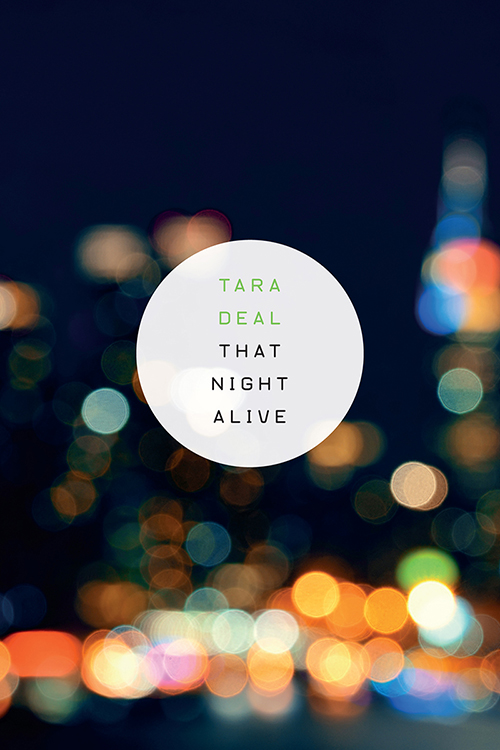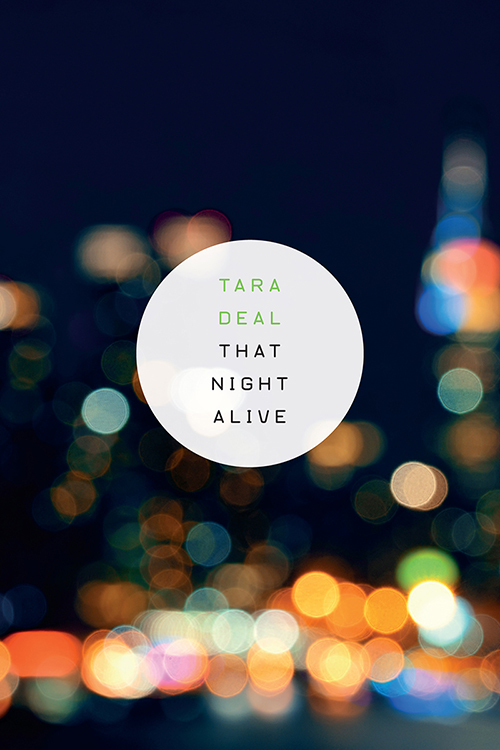
In Tara Deal’s That Night Alive, a young crypto-reporter pulls us backward through her life as a writer by way of her sporadic, journal-like entries. We begin on the eve of her predetermined death date—due to an unnamed disease—on which her final moments are being spent under the warmth of a velvet blanket, looking out at the city lights. From the first account, number thirty-four, we move in reverse through her life in a seemingly post-apocalyptic future, where croissants are outlawed and expression is controlled. We watch our narrator’s past become the future of the novel, and observe as the ribbon of choices which led to her known fate continually unravel before us. We feel the weight of the ominous “they,” who have a vague, yet heavy presence in the narrator’s entries, as she struggles to reconcile her sacrifice of artistic freedom in return for the comfort and security of a career in crypto-reporting—and the surveillance that accompanies this. Our narrator ruminates on her choices at nearly every turn, constantly reassuring herself that they are necessary, even rewarding. We know from the beginning, however, that they are not. In a world where shady figures make green marble bathrooms and luxury body potions appear for the willing young writer, the choice to accept a life of supervision proves itself to be empty. Ultimately, our narrator dreams of writing something lasting, meaningful—a dream that eludes her.
While exposition and backstory are sparse, Deal’s unconventional structure and nonconcrete world-building are effectively employed through the intimate lens of the narration. Even in choosing to tell this story in reverse, Deal achieves a character whose identity unfolds from beginning to end. We move from a restricted, quiet narrator to one with voice, opinion, and life. Deal achieves all the elements of surprise and intrigue that a conventional novel does and more, asking her reader to probe the text, to sift for clues and connections that illuminate the story. Though her structure choice is unusual, it proves to be the perfect decision for this narrative, as we are never denied the opportunity to watch our narrator bloom.
Deal simultaneously weaves a second, counternarrative in That Night Alive, which is composed of what the narrator calls her “micro-memoirs,” some written on paint chips she’s collected over the years from her numerous apartments: “Paint chips are one of [her] mnemonic devices, for remembering what living here is like.” These micro-memoirs are flash-like glimpses that stand on their own, like photographs that show only a moment in time, and are ordered in a conventional, first-to-last progression, in contrast to the thirty-four accounts. The paint-chip narratives blend prose and poetry, creating images that seem clear, until all at once they elude our grasp. On paint chip “Nacre,” the narrator writes, “Then uptown in the drizzle, I walk by a discarded cardboard box that says: Become your Dream. The message has been written in thick black marker. But the box is ripped, a little soggy. It will not even be a box for much longer.” And earlier, on “Crimson,” “I overheard a professor ask his student: could love of one’s work equal love of a person? Could a monk with his manuscript be as devoted as that couple close together over there, under an umbrella? It was that hour when the air starts to turn purple (violet). Yes, of course, why not. That was the answer to the professor’s question.” These flashes of life deepen our understanding of the narrator, of her fear of denying herself and her desire to write something important, for security or even luxury.
The micro-scope of the novel refuses the big picture or broad lens that many novels and most motion-pictures provide. Deal keeps our view limited to the narrator on a close and intimate level that allows the reader to invest themselves into this sole character—her desires, fears, failures—rather than the world. As we reach the end of the novel, and subsequently the earlier part of the narrator’s life, “Account 1” ends with this: “Just a stack of old-fashioned paper. But I keep it hidden, in any case. I know that much. Not to expose myself. I can abandon it later, after I have accomplished something. How many times do I have to convince myself: accomplish something.” Because the first page of the story lets us know that this feeble dream never came to fruition, moments like this make us sympathize even more deeply with the young writer whose fate we are already familiar with. In the final entry, paint chip “Pine,” our narrator leaves us in a nearly identical state as we began: she’s poured her final glass of champagne, wrapped herself in a velvet blanket, watching the lights of the city go out.
Tara Deal’s That Night Alive is a futuristic, contemplative meditation on the transitory nature of life, the suffocation induced by a world under surveillance, and the eternal struggle to funnel creative expression into a work that will live long after its creator. Her employment of a double-narrative style, each progressing in opposition to the other, acts like a multi-faceted gem: we come to know the narrator from multiple angles, which, in the end, come together to reveal her character in its fullness. Deal’s novel offers an unconventional commentary on what it means to sacrifice, submit, and ultimately die believing you’ve failed to accomplish your purpose. Deal fuses poetic style with prose narrative, captures extraordinary detail with the simultaneous blur of human memory, and carries her reader through Tokyo, Paris, and New York City in one swift motion. While there are times where clarity might have been sacrificed to maintain the haziness of the narrative style, Deal nonetheless delivers both the depth and nuance of human life in what feels like a glimpse.
That Night Alive, by Tara Deal. Oxford, Ohio: Miami University Press, September 2016. 113 pages. $15.00, paper.
Rachel Sharp is a senior at Winthrop University in South Carolina, and the Editor-in-Chief of The Anthology, Winthrop’s Arts & Lit magazine. When she finally graduates, she’ll be pursuing her MFA in Creative Writing.
Check out HFR’s book catalog, publicity list, submission manager, and buy merch from our Spring store. Follow us on Instagram and YouTube. Disclosure: HFR is an affiliate of Bookshop.org and we will earn a commission if you click through and make a purchase. Sales from Bookshop.org help support independent bookstores and small presses.


Leave a comment